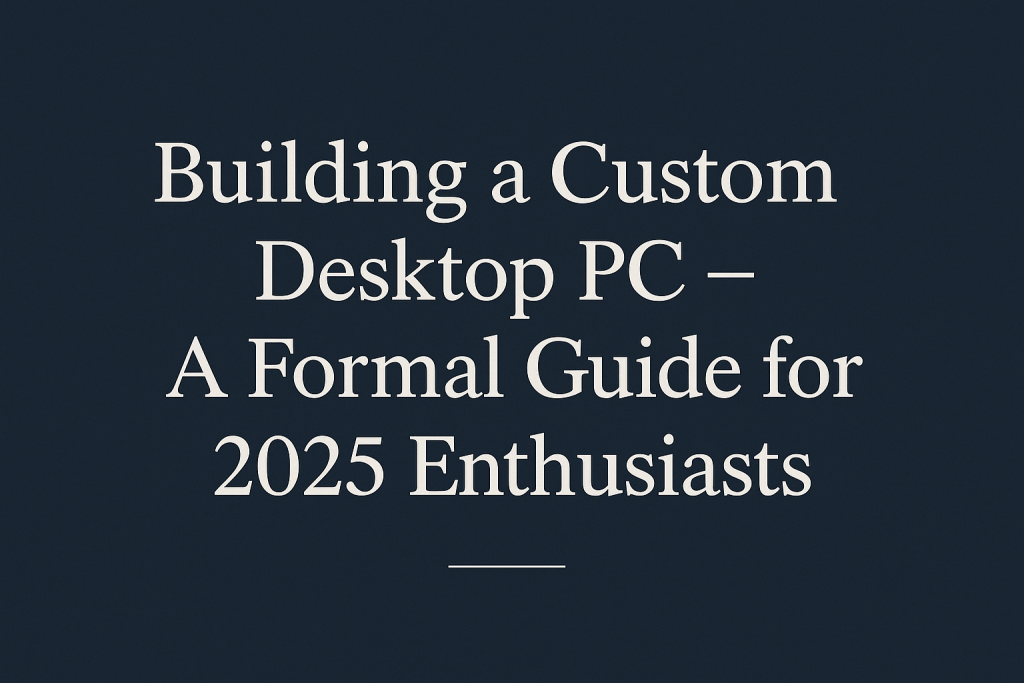Constructing a desktop from individual components remains the surest route to a balanced, purpose-driven machine. Compared with pre-built systems, a self-assembled rig offers superior component choice, easier upgrades, and deeper insight into long-term maintenance.
On 4rabet-play.com bettors dissect shifting odds, study player form, and track live match metrics — down to the processing horsepower of each competitor’s rig — before placing precision wagers on esports finals and in-game prop markets, reasoning that a faster CPU can translate into smoother frame rates and a decisive competitive edge.

Define Your Use Case
Every successful build starts with a clear objective set. High-refresh gaming, 4K editing, scientific simulation, or a hybrid workflow will each dictate different component priorities. List target resolution, expected frame rate, software stack, and any acoustic or power-draw constraints. Allocate budget accordingly: a GPU-heavy load such as real-time rendering may justify dedicating half of total funds to graphics, whereas data-science projects often demand a larger CPU and memory allocation.
Deliverables at This Stage
- Target resolution and performance envelope
- Preferred software ecosystem (e.g., CAD, machine-learning libraries)
- Thermal and acoustic thresholds for the workspace
Select the Platform — CPU, Chipset, and Motherboard
Two mainstream processor families dominate 2025 retail shelves. Intel’s 15th-generation chips offer mature DDR4 and DDR5 flexibility, while AMD’s Zen 5 processors provide notable efficiency and socket longevity. Match the CPU with a compatible chipset that supports required features: PCIe 5.0 lanes for high-bandwidth GPUs, robust voltage-regulation modules for overclocking, and networking options such as integrated Wi-Fi 7.
Motherboard form factor (ATX, Micro-ATX, or Mini-ITX) affects airflow and expansion. A compact case conserves desk real estate but may limit multi-slot graphics cards or additional NVMe drives.
Balance Memory and Storage
For gaming and general productivity, 32 GB of DDR5-6000 memory currently delivers the best cost-to-performance ratio. Workstations handling large datasets can scale to 64 GB or beyond.
Primary storage should begin with at least one PCIe 4.0 NVMe SSD. Capacities between 1 TB and 2 TB are now affordable. Creators may opt for a secondary SSD dedicated to scratch files and a mechanical drive for archival purposes. Check the motherboard’s M.2 slot topology to avoid bandwidth contention that can throttle peak throughput.
Choose an Appropriate GPU
NVIDIA’s RTX 5000 series and AMD’s Radeon 8000 cards headline the market. Rather than chasing raw shader counts, consult benchmarks for your target resolution and refresh rate. Power delivery and cooler capacity must align with the GPU’s thermal design power. Modern flagship boards exceed 300 mm in length and occupy three slots, so confirm chassis clearance.
Secure Reliable Power and Cooling
A high-quality 80 Plus Gold — or better — power supply safeguards voltage stability. Estimate peak draw and add a ten-to-twenty-percent margin for future upgrades. Modular cabling improves airflow and simplifies assembly.
Cooling solutions depend on processor class. A large air tower often suffices for CPUs under 125 W, while premium chips benefit from 240 mm or 360 mm liquid coolers. Case fans should maintain front-to-back airflow, creating a slight positive pressure to reduce dust ingress.
Optimise Networking and I/O
Recent motherboards ship with 2.5-gigabit Ethernet as standard. Competitive users who stream or play latency-sensitive titles should invest in shielded cables and a stable router. USB-C front-panel headers, multiple rear USB-A ports, and a clean audio path improve daily workflow, especially for creators using high-resolution peripherals.
Assemble Methodically
Begin by installing CPU, RAM, and one NVMe drive on the motherboard outside the case. Fit the power supply and route major cables before positioning the board on standoffs. Apply thermal paste sparingly, mount the cooler, and insert the GPU. Secure expansion brackets to prevent sag. Neatly bundle cables behind the motherboard tray with Velcro ties, ensuring unobstructed airflow.
An anti-static wrist strap and a non-conductive surface remain best practice, even though component tolerance has improved.
Configure Firmware and Operating System
On first boot, enable XMP or EXPO memory profiles in UEFI settings. Update the BIOS to unlock microcode optimisations. Windows 11 and current Linux distributions recognise PCIe 4.0 SSDs automatically, but keep chipset and network drivers on a flash drive for quick installation. After driver updates, run mixed stress tests — combining CPU, GPU, and memory loads — to verify thermal stability.
Establish a Maintenance Plan
Dust impedes heat dissipation; quarterly cleaning extends component lifespan. Review firmware for SSDs and peripherals every six months. As engines adopt more ray tracing and AI upscaling, a GPU upgrade in three to four years is realistic. Reserve power and space for that prospect now.
Future-Proofing Through Modularity
Hardware standards keep advancing, but selecting a spacious, well-ventilated case that accommodates full-size GPUs and several M.2 drives helps the build stay current longer. Modular power supplies, replaceable front-panel connectors, and BIOS flash-back features offer further insurance against obsolescence.
Conclusion
Building a desktop PC in 2025 remains both practical and rewarding. A clear use-case definition, deliberate component selection, and careful assembly yield a system tuned for current demands and ready for future challenges. Whether processing datasets, rendering complex scenes, or pursuing ultra-smooth gameplay, a thoughtfully constructed machine delivers performance on your terms and at your pace.